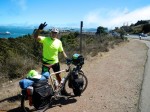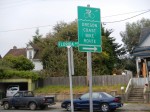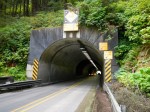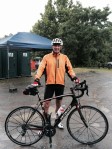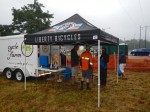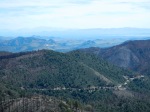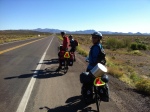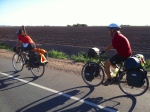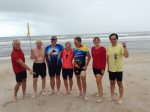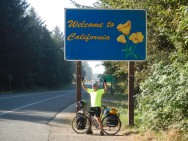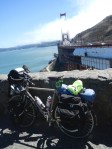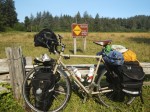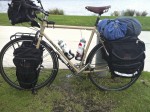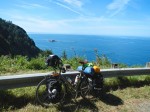What gear do I bring, how to pack, what kind of bicycle is best, what kind of terrain and what about the weather, where to camp and on and on. The Southern Tier is a popular bicycle route that goes from San Diego CA to St. Augustine FL. At only 3,200 miles, and 65 days or less, this is also the shortest coast to coast route for cycling. I completed this ride in 2013 with a group of ten others cyclist from the Adventure Cycling Association. Their website is here if you want more information. This article is about my personal experiences riding the Southern Tier, (ST) and not an article on touring with the Adventure Cycling Association.
Here is my packing list of items-3 pair cycling shorts, 3 dry fit shirts (not zip up cycling jerseys), 3 pair socks, 1 pair sandals, 1 pair long dry fit or nylon pants, 4 spare inner tubes, 1 spare fold up tire, 1 can of 4oz Fox Labs pepper spray, 1 sun hat with brim and drape to cover my neck, 1 Showers Pass rain jacket, rain pants, rain shoe covers, rain cover for my helmet, cycling gloves long finger, rain gloves, LED light with headband, 1 pair cycling shoes SPD cleats, 1 REI pack towel, 1 pair running shorts, 1 insulated shirt, 2 man tent from (Link- Big Agnes) , Big Agnes sleeping bag (Link–Big Agnes) tent ground cover, camp pillow, inflatable pad for sleeping bag, US Army poncho liner, plate, cup, knife, fork, spoon kit, insect repellent, sunscreen, and toiletries, and toilet paper. In addition, I carry as many as six each .75 liter water bottles and wear a 3 liter backpack from Osprey (Link-Manta 28). The backpack is handy for carrying wallet, cell phone, pepper spray and items you want to keep with you when you are off your bike. The tendency is to carry way too much gear, most riders wind up shipping items back home and purchasing other items as you go along. My average gear weighs about 65-75 pounds and add in the weight of the bike, racks and panniers of about 35 pounds I total 100 plus pounds. For crossing the desert with all water bottles and 3 liter backpack full I am easily over 120 pounds. This is about the average weight for this tour due to the desert conditions and remote areas. You may go for over 50 miles with no services, no food, and no water so you must bring it with you.
Here is my loaded rig in the desert:
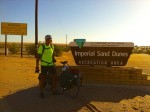
Camping on the Southern Tier- Campgrounds in the western part of the route are mostly fair to acceptable with showers, flat ground for camping, and a few actually have grass and trees. Others are hard packed baked dirt to sand with sand spurs and goat heads that stick to your shoes and tires. Goat head spurs are dangerous as they can puncture bicycle tires and will easily injure you if you step on them with bare feet. There were only about 3 camping areas where there were no showers but these did have running water available. Washing clothes and hygiene are very important on any tour. By the end of the day I’m sweaty, tired and dirty and cleaning up was the highlight of the day, even if it was just sticking my head under a water faucet. I washed clothes daily by stripping off my socks, shorts and shirt and laying them on the floor of the shower and walking on them as I showered. I bring a pair of running shorts and sandals to wear from the shower and walking around the camp. Clothes dry quickly in the southwest by hanging them on a fence, or a tree limb. 15 minutes and everything is nice and dry. Some campgrounds have electricity for charging electronics, air conditioned common areas, soda machines, BBQ grills and a few even have wifi if they are close to a city. On the other end of the scale is remote camping areas with no electricity, no cell service, no wifi and only an outdoor water faucet. McDonalds restaurants are a welcome site along the route as they have cold filtered water to fill water bottles and wifi. I stopped at almost every McDonalds just to check email and refill water bottles. I put my panniers in my tent most nights. For me a 2 man tent is required as I like to have my panniers on one side and I sleep on the other. I lay out the next days socks, pants, and shirt in one corner of the tent, my iPhone serves as my alarm clock, and keep my small led light with headband close by in case I have to get up in the night. My Casio watch also has an alarm feature and a light that comes in handy. I do not carry insect spray to kill mosquitos, but I do use insect repellent in small pump spray bottle with 100% DEET. Search for Repel 100, it is light weight plastic bottle and not an aerosol can. Works great. I have also used it to spray around the outside of my tent where there are ants and also works to keep other crawling bugs out of your tent. Here is a photo of the route and a thermometer in the shade at our day 1 campground at around 6PM at night it is 110 degrees in the shade in the desert east of San Diego CA.
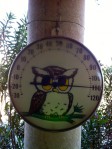

Touring Bicycles- Almost any bicycle can be used to cross the Southern Tier. However just like there are cars such as SUV’s that are better suited for carrying lots of gear, there are bicycles that are designed to tour with full loads of gear. The single biggest problem I see on the road touring is with tires and wheels. Riders with a hybrid bike made for commuting around town with light loads such as rider and backpacks are comfortable for a few hours and hold up well for their designed purpose. Hybrids do not make good self contained touring bikes, they are simply not designed for this. Touring bikes are designed from the frame up to withstand the rigors of carrying heavy loads over long distances with brakes, shifters, and gear train to handle the stress. Touring bikes have longer chain stays so your heels don’t hit your rear panniers, beefier forks, a more upright riding position, a frame made of steel and heavy duty wheels with 36 spokes. Steel frames provide a sturdy framework that can flex slightly for comfort, 36 spoke wheels can handle the stress of carrying heavy loads without breaking spokes. A triple crankset with 26-36-48 gears and a 9 speed rear cassette of 11-32 will get you over any of the mountains. If you run out of gears or run out of the energy to climb over the mountain simply stop and take a break or push the bike over the climb. That’s right folks, I said it is OK to push your bike over a steep hill. Touring for me is not a race, it’s an adventure. There is a lot of information on touring bikes, one of the most popular touring bikes on the road is the Surly Long Haul Trucker. You can read more about this bike on my blog. Complete specs on this bike is here, Surly Long Haul Trucker

Surly Long Haul Trucker
Road hazards- This route is over 3,200 miles and for the most part is safe for cyclist. Just like any other route there are road hazards, extreme temperatures, dogs, traffic, not so nice drivers, tunnels, bad roads and even Interstate highways to traverse. Add all these together, and they are simply just part of the adventure. What kind of tires for the ST? I only use Schwalbe touring tires as do most of the other experienced touring cyclist. I use the Marathon Supreme HS382 foldable tire. You can see the full line of Schwalbe tires here. I carry one spare tire in my pannier in case I damage a tire on the tour. I changed out the rear tire at about 3,000 miles and it would probably go another 1,000 miles if needed. I experienced about 5 flats on the rear tire in that 3,000 miles. Most of the flats were due to ghost wires. Ghost wires are the small wires used to manufacture the steel bands in big truck tires. When the truck tire gets low on pressure it heats up and at highway speeds the tire will eventually disintegrate and tear the wire bands apart, spewing small pieces of the wire all over the road where they end up on the shoulder like a minefield for cyclist. The Schwalbe front tire still looked good after 4,000 miles. I carry 4 inner tubes and a patch kit with me on all my tours. Dogs? I find that 90% of dogs that chase after me do not want to attack or bite me. They bark, chase, run along side for the length of their property and go back to their yard. Usually I can yell STOP at them and this works, others I can point my can of pepper spray at them and this works, some dogs seem to recognize the spray can and immediately stop. However there are dogs that do not respond to commands and appear very aggressive. No matter what your feelings are toward aggressive animals, Pepper spray works. You generally do not have to spray the dog in the face, just the smell of the mist from the air will immediately stop the aggressive dog. I always carry a can of Fox Labs 4oz aerosol spray while on tour. Lights and mirrors I use a rear red flashing light on the back of my gear and I use a handlebar mirror to watch traffic coming up behind me. I would not tour with these two safety items. I also have a helmet light set that has a bright LED front light and a red LED for the rear. I only use this for tunnels or fog or rain. Here is a photo of the rear of my Surly showing the lights and mirror.

Recommendation- I highly recommend anyone wanting to tour the (ST), Southern Tier, to first sign up for a shorter tour with the Adventure Cycling Association. You can learn the ABC’s of self contained touring and this provides you some real world experience before you set out on an epic 2 month long adventure. I do not recommend touring the ST alone. This is not a beginners tour to tackle by yourself due to the extreme conditions of the desert, long steep climbs over 8,000′ mountains and remote areas where no one should be on the road by himself.
Movie of Emory Pass New Mexico 8,295′ highest elevation but not the most difficult climb on the ST.

